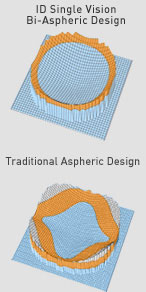
|
The Problem
SV eyewear using finished stock lenses or spherical semi-finished lens blanks, deliver the same lens design (toric back curves) for every patient with the same Rx, regardless of the frame chosen. That creates small changes in the effective central Rx but larger compromises to the vision in the lens periphery (anywhere away from center). In fact, many SV lenses have been made flatter for better cosmetics (less bulge) and that has further reduced peripheral clarity. Wasn't an issue in very small frames but just look at the frame sizes in 20-somethings, they're bigger now. Digitally enhanced, optimized SV lenses will almost always deliver a better edge to edge design for the Rx. In addition, the up charge for atorics and optimized SV lenses is less than progressives so the cost may be more acceptable to patients budgets and dispensers attitudes.
What do I recommend?
- For the very next Flat Top patient with more than 1D cyl, order an atoric lens. In fact, an atoric lens in SV, FT and traditional progressives works great. Patients will notice the difference in vision.
- For the next higher power and/or higher cyl patient, sell an optimized SV lens. The entire lens will be redesigned for that patient's Rx in the frame that they chose. To further refine the lens, consider taking and supplying your own tilt, wrap and vertex measurements.
- For patients with Rx's near plano, spend the extra money, for now, on a pair of Rx sunglasses.
Contact lens wearers are wearing their SV glasses more since they see as good as they do with their contacts. That means they also purchase better looking frames.
Free-form SV is still not an Internet eyewear product. A colleague had a patient request that he change the lenses in their glasses purchased online to those new digital lenses they had recently picked up.
Have an opinion on Free-form SV? Let me know.
Mark
Mark Mattison-Shupnick
Director, Education and Training












